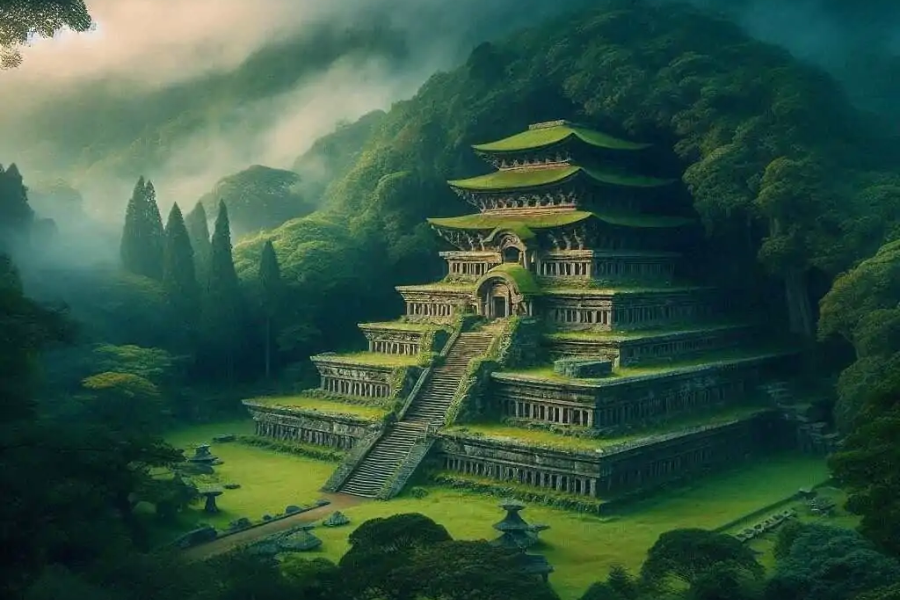“The Mystique of the Sankaka Complex: Exploring Ancient Ingenuity”
When it comes to ancient structures that continue to intrigue historians and archaeologists, the Sankaka Complex stands out as one of the most captivating. Nestled in a historically rich location, this ancient wonder leaves scholars pondering its origins, purpose, and the civilization that created it. If you have a passion for ancient architecture and the secrets of bygone eras, this exploration is for you.
What is the Sankaka Complex?
The Sankaka Complex represents a historical enigma—a monumental structure built thousands of years ago, yet its precise function remains shrouded in mystery. Comprising an extensive array of intricately designed buildings, passages, and symbolic structures, it captivates the imagination of many. While some theorize it served as a religious site, others suggest it functioned as an astronomical observatory. What is evident, however, is its significant role in ancient society.
Misconceptions Surrounding the Complex
Numerous misconceptions exist about the Sankaka Complex. Some argue it was a city, while others insist it was purely a ceremonial site. However, historical evidence implies that the complex was likely multifunctional, serving not only religious or ceremonial roles but also acting as a center for education and governance.
Historical Context
The origins of the Sankaka Complex remain obscured by time. Early archaeological findings date its construction back to an era when ancient civilizations were beginning to hone their building techniques. Its discovery in the early 19th century ignited fervent interest among researchers, who endeavored to piece together its history from the architecture and surrounding artifacts.
Importance in Ancient Civilizations
The Sankaka Complex was far from an arbitrary construction. Its layout, design, and functionality suggest a society with advanced knowledge in engineering, astronomy, and spirituality. Scholars propose that it may have served as a central venue for religious gatherings, political discussions, or even astronomical observations.
Geographical Significance
Located in a region rich in cultural and historical significance, the Sankaka Complex stands amidst rugged landscapes, showcasing the ingenuity of ancient builders who adapted their designs to their environment.
The Context of Its Surroundings
The area surrounding the complex was historically vital due to its abundant natural resources and strategic importance. The people who constructed Sankaka likely had access to trade routes, which facilitated cultural exchanges that influenced the complex’s design and construction.
Architectural Wonders of the Sankaka Complex
One of the most remarkable aspects of the Sankaka Complex is its architecture. The ancient builders, without modern tools, crafted structures that have endured through time. The complex features massive stone blocks, elaborately carved facades, and precise alignments, indicating a profound understanding of mathematics and astronomy.
Distinctive Architectural Characteristics
Among the many intriguing features of the Sankaka Complex is its distinctive use of geometry and celestial alignment. Certain buildings within the complex are oriented towards celestial bodies, suggesting the builders’ sophisticated astronomical knowledge. Furthermore, the layout appears to adhere to principles of sacred geometry, enhancing its spiritual significance.
Artistic Expression and Symbolism
Beyond being an architectural achievement, the Sankaka Complex is also an artistic treasure. Its walls boast intricate carvings that depict religious symbols, celestial bodies, and abstract designs. These artistic elements provide a window into the spiritual life of the people who inhabited and utilized the complex.
Symbolic Meaning in Design
Many carvings within the site seem to possess deep symbolic meanings. Scholars speculate that the complex itself was designed to mirror the cosmos, with its structures and pathways emulating the movements of celestial entities. This indicates that the complex may have functioned not only as a religious center but also as a hub for learning and astronomical studies.
Religious and Spiritual Importance
The Sankaka Complex likely played a crucial role in the religious practices of its community. The various carvings and structures found within suggest it was a venue for religious ceremonies, rituals, and spiritual gatherings.
Impact on Spiritual Practices
The design of the complex, with its celestial alignments and symbolic artworks, likely served as a focal point for ancient religious customs. It may have been a gathering place for priests, scholars, and leaders to worship, observe celestial phenomena, and make significant decisions.
The Enigma of Its Construction
One of the most profound mysteries surrounding the Sankaka Complex is the method of its construction. Without modern machinery, the ancient builders successfully transported massive stone blocks and erected towering structures that have stood for centuries.
Theories on Construction Techniques
Several theories propose how the builders achieved this feat. Some suggest the use of simple machines like pulleys and levers to move stones, while others argue that a deep understanding of geometry and engineering allowed for the precise construction of such enduring structures. Nevertheless, definitive evidence explaining the building methods remains elusive.
References in Ancient Literature
The Sankaka Complex finds mention in a few ancient texts, though these references are often vague and cryptic. Some scholars believe these writings may contain clues regarding the complex’s purpose and significance, but much is still yet to be uncovered.
Perceptions of the Complex in Antiquity
Ancient literature often describes the Sankaka Complex as a site of great spiritual and astronomical importance. Some texts imply that it served as a center for learning, where scholars and priests gathered to study the stars and conduct sacred rites.
Scientific Investigations and Research
Over the years, the Sankaka Complex has attracted numerous archaeological and scientific inquiries. These investigations have provided valuable insights into its construction, purpose, and cultural significance.
Archaeological Discoveries
Excavations at the site have revealed various artifacts, including pottery, tools, and carvings that shed light on the daily lives of those who built and utilized the complex. Additionally, carbon dating has helped establish a rough timeline for its construction.
Myths and Legends Surrounding Sankaka
The Sankaka Complex has inspired a multitude of myths and legends throughout history. Some speculate it was erected by a lost civilization, while others posit it served as a landing site for ancient extraterrestrial visitors. Although these theories may seem far-fetched, they reflect the enduring sense of mystery that envelops the complex.
Contemporary Theories on Its Function
Modern scholars suggest that the Sankaka Complex was likely a multifunctional site, serving as a religious, political, and astronomical center. Some even propose that its structures and alignments functioned as a calendar to mark significant celestial events.
Current Preservation Status
Regrettably, the Sankaka Complex is not as well-preserved as it once was. Over the centuries, natural erosion, human activity, and environmental factors have caused significant deterioration.
Preservation Efforts
Efforts are underway to protect the complex, with archaeologists and historians striving to restore its structures and shield it from further damage. However, these initiatives often face challenges due to limited funding and resources.
Cultural Legacy of the Sankaka Complex
The Sankaka Complex has left an indelible mark on modern culture, influencing various fields such as architecture and art. Its distinctive design and enigmatic origins have captured the imaginations of many, making it a popular topic in literature, film, and documentaries.
Impact on Contemporary Culture and Architecture
Many modern architects have drawn inspiration from the Sankaka Complex, integrating its geometric designs and celestial alignments into their own creations. Its influence is also evident in popular media, where it is frequently depicted as a mystical and otherworldly locale.
Tourism and the Sankaka Complex
The Sankaka Complex has emerged as a prominent tourist destination, drawing visitors from across the globe eager to explore its ancient ruins and uncover its historical narratives.
Tips for Visiting the Site
For those planning a visit to the Sankaka Complex, there are essential points to consider. The site is remote and can be challenging to access, so careful trip planning is crucial. Visitors are also encouraged to respect the site’s cultural significance by adhering to all rules and guidelines.
Summary
The Sankaka Complex is a captivating ancient structure shrouded in mystery, located in a historically rich region. Its origins remain unclear, with researchers debating whether it served as a religious site, astronomical observatory, or multifunctional hub for governance and learning. Despite numerous misconceptions, evidence suggests that it played a significant role in ancient civilization.
The complex features remarkable architecture, with massive stone blocks and intricate carvings that showcase advanced engineering and artistic skill. Symbolism is deeply embedded in its design, reflecting a profound understanding of geometry and celestial alignments. This suggests that the complex was not only a site of worship but also a center for spiritual and astronomical study.
Although the methods used for its construction remain a mystery, theories propose the use of simple machines and advanced geometry. Over time, the complex has appeared in ancient texts as a place of great significance, and archaeological studies have revealed artifacts that shed light on its history.
Today, the Sankaka Complex faces preservation challenges due to natural erosion and human impact. Despite this, it continues to influence modern culture and architecture and remains a popular tourist destination for those eager to uncover its secrets.
FAQs:
1. What is the Sankaka Complex?
The Sankaka Complex is an ancient structure characterized by its intricate buildings and corridors, believed to have served multiple purposes, including religious and astronomical functions.
2. Where is the Sankaka Complex located?
The complex is situated in a historically significant region known for its rich cultural heritage, amidst rugged landscapes.
3. What is the significance of the Sankaka Complex?
It reflects advanced engineering and architectural skills of ancient civilizations and may have served as a center for religious gatherings, political discussions, and astronomical observations.
4. What are some common misconceptions about the Sankaka Complex?
Some believe it was solely a city or ceremonial site, but evidence suggests it had multifaceted uses, including learning and governance.
5. How was the Sankaka Complex constructed?
The exact methods of construction remain unclear, but theories suggest the use of simple machines and a deep understanding of geometry and engineering.
6. What is the current state of the Sankaka Complex?
The complex is facing preservation challenges due to erosion and human activity, but efforts are being made to restore and protect it.
7. How has the Sankaka Complex influenced modern culture?
Its unique design and mysterious origins have inspired architecture, art, and popular media, making it a subject of fascination worldwide.
8. Is the Sankaka Complex open to tourists?
Yes, it is a popular tourist destination, although visitors are encouraged to respect its cultural significance and follow guidelines while exploring the site.
Stay in touch to get more news & updates on Realblog!






